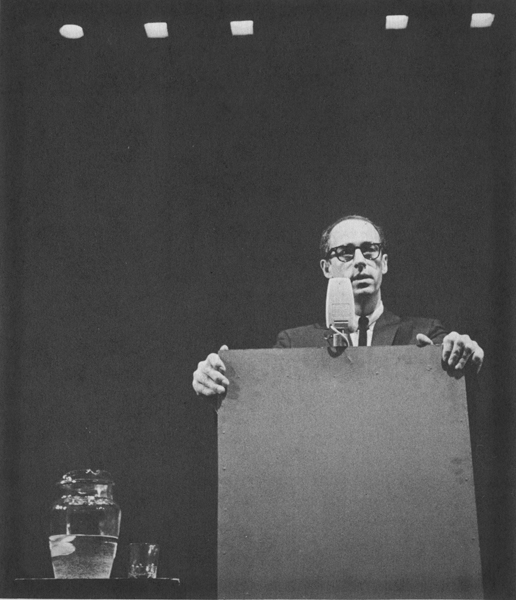code flow - events
Dimitrina Sevova – A Lecture-Performance about the Practice of Lecture-Performance (No more representative theater! A thousand desiring machines, let a thousand flowers bloom!)
24 August 2013
Sanatorium: 17:00-20:00

Robert Morris performing 21.3, sur+ Dance Theater, Stage 73, New York, 10 February 1964
The lecture performance as a performative art practice is situated in multiple coordinates that cannot correspond to any genre, let alone a school, and goes right past pedagogical manners and mediation as techniques of signifying and control of the public or older methods of discipline imposed by the assembly line of the school institution or the factory of knowledge itself. A Lecture Performance about the Practice of Lecture Performance investigates the appearance of this form in the field of art by applying its own methodology, being itself a lecture-performance, in order to escape existing categorizations both in the system of art and in academia. The lecture performance is a process-oriented practice exploring and complicating the semantic codes coming from different signifiers and creating rather a field of noise than of clear statements. It thus aims to provide some insight in the method of dramatization, which is always a politics of time, taking into consideration the social and political context where it takes place, oriented to new relations with its public to blur normative forms of recognition and organization of the production of knowledge.
Through a variety of non-chronologically situated examples and appropriated materials from artists like Robert Morris, Andrea Fraser, Adrian Piper, Yvonne Rainer, John Cage as well as more recent examples, A Lecture Performance about the Practice of Lecture Performance, composed of fragments, raises the question of what affect is, and what is there to affect and be affected, itself creating a dynamic and unstable situation which is the condition of being of this artistic practice, difficult to define in its aesthetic and knowledge forms.
The practice of lecture performance strives to overcome the split between the gesture and the linguistic machine which disconnects the corporeal from the conscious and unknown, by incorporating representative and non-representative bits from different sources in order to call forth the curiosity of the public (not its attention, nor its ability to judge).
The practice of lecture performance is no longer the theater of actors, not the lecture of a visiting professor. Its roots go back to conceptual art and institutional critique, as well as the performance and dance practices of the 1960s and 1970s. It draws the field of knowledge and the aesthetic field back to the unknown, as an inventive practice and act of creation rather than a representational theatre of knowledge, and manifests itself as a formal discontinuity. It is rather a trail of questions, fumblings and stumblings in a dynamic field of affects and expressions, aimed at opening a box of transversal tools.
The practice of lecture performance, as every form of knowledge creates a place of quasi-objectivity – a way of posing questions that appear out of an ontology as a manifestation of new forms, poking into the invisible as well as the visible, outside of any historical determinism or distinction between fictional and historical material, maintaining that every aesthetic form is the expression of singularities.
This is neither a form of knowledge, which would have the tendency to produce a total system, nor a form of representation. A lecture performance is the closest one can imagine to a philosophy of art – a philosophy of both the body and the mind. A philosophy of art could not possibly be a systematic discipline, or a genre. A philosophy of art can be an idea investigating movements, because it is itself a form of organization which animates its own movements, a principle of composition and re-composition of materials of various sources and research in a transdisciplinary field, which no longer allows a distinction between theory and practice, meaning and non-meaning, the event and its documentation.
The lecture performance creates a dynamic situation in a particular space and time, its own spatio-temporal dynamics retranslating the time in which it is happening, incorporating a lot of footage and sound bites besides real-life language.
The lecture performance is a practice critical of the automatic space of attraction and reflection, reconsidering the process of affirmation they imply, in order to invent a new relation to knowledge and movement within its public. The lecture performance is a self-reflective practice, but not as an auto-poietic repetition of opening and closing by which to signify the public. The lecture performance is thus even more so a self-inventive practice, a multiplicity of aesthetic and living forms of knowledge. It is therefore a multiplicity of ideas and bodies and their field of individuation where the vectors of singularization stretch through space and time – a concept that is not a form of representation, or a statement, which is always a form of group enunciation.